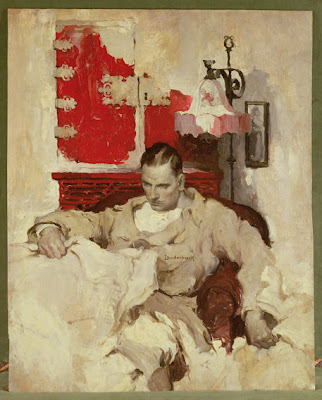The illustrations of Walt Louderback are filled with an atmosphere of romance and drama. Like Dean Cornwell (1892-1960), Louderback worked for Cosmopolitan magazine during the early 1900s. The two men (who may have been friends) shared a painterly technique and a flair for mood, intrigue, and dramatic action in their pictures. That approach came to Louderback and Cornwell honestly, for Cornwell was a student of Harvey Dunn (1884-1952), who was in turn a student of Howard Pyle (1853-1911), the father of American illustration. Both Louderback and Cornwell would have studied illustration at a time when Pyle strode the earth like a giant.
Walter S. Louderback was born on February 3, 1887, in Valparaiso, Indiana, and--like Dean Cornwell--studied at the Art Institute of Chicago. He illustrated stories for Cosmopolitan, Good Housekeeping, Hearst's International, and other popular magazines. Many of those stories were also printed in hardbound editions with Louderback's illustrations. Readers of the 1910s and '20s would have been well acquainted with the art of Walt Louderback, as he illustrated books by one of the most popular authors of the day, James Oliver Curwood (1878-1927). In addition to being an artist, Louderback also taught at the Art Institute of Chicago. Robert Patterson (a student) and John Clymer (a boyhood admirer) were among the illustrators of a younger generation influenced by him. Today, Louderback is a much under-appreciated artist.
During the 1920s, Louderback lived in Europe and delivered his assignments to New York by surface vessel. He also experimented with modernist and Cubist painting. As war loomed, Louderback left Europe with his family in May 1939. He died at a sanitarium in Socorro, New Mexico, on October 15, 1941.
 |
| An illustration by Louderback for an unknown story. If this scene was set in Monte Carlo, Louderback may have studied his sources from life, for he lived in Europe during the 1920s and '30s. |
 |
| A typical Louderback treatment with a high vantage point and details around the edges left out. Oddly, the artist's signature is on the man's clothing. |
 |
| A moody and dramatic illustration that approaches portraiture. Note the Oriental motif in the background. |
 |
| Another illustration for an unknown story. The painting is called "The Homecoming." I wonder if Louderback would have experienced such an event upon his return to the United States in 1939. |
 |
| An illustration for "Tongues of Flame" by Peter Clark Macfarlane [sic]. The source for this image says: "probably Cosmopolitan, 1923." |
 |
| This illustration for an unknown story is one of the most striking I have seen by Walt Louderback. Romantic, atmospheric, melancholic, suggestive of menace, it could be the cover of a Gothic romance of today. Probably painted eight decades ago, this canvas is as fresh and contemporary as the day it was created. (Sorry for the red line through the image.) |
Text copyright 2012, 2024 Terence E. Hanley






Thanks for opening up my eyes to the world of this great illustrator. The golden age of illustration is gone, and with it these highly prolific virtuosos of pencil and brush. The art that they produced is a national treasure. The students of these men are daily a vanishing breed. Their topical breadth and range of skills is rarely found in the artists of today.
ReplyDeleteI have an original painting by him that's very dramatic. It's been in the family since 1950
ReplyDeleteHello. Thank you for this information. I just purchased a small painting by Louderback, and am very glad to get the biographical information.
ReplyDeleteDH
Dear Anonymous, bd2. . ., and DH,
DeleteYou're welcome, and I'm glad you enjoyed or benefitted from my article on Walt Louderback.
TH
Dear all,
ReplyDeleteI have an oil painting signed by him, inherited from my grand mother who lived in Nice (France).
It is called Spanish sail boats. Its size is 34x32 inches or 88x82 cm.
I'd like to sell it.
Could you advise me how to do ?
Which auctioneers are the more appropriate for this painter ?
Thanks
rxr1901@gmail.com
Does anyone know the palette of colors he would use in the 1920's? Curious about his use of green - looks like viridian?
ReplyDelete